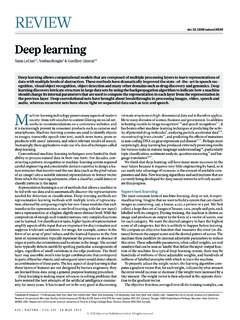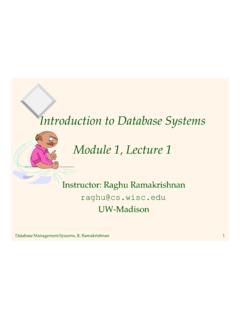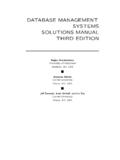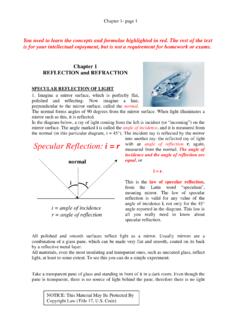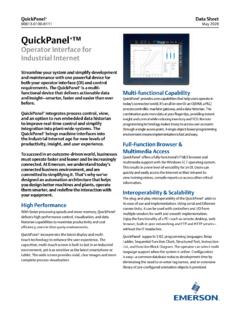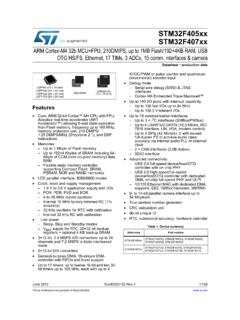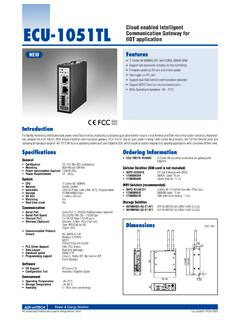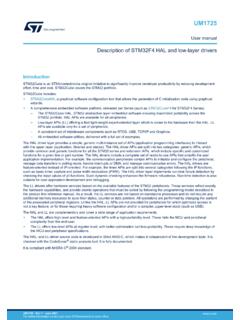Transcription of Flash-based SSDs - University of Wisconsin–Madison
1 44. Flash-based SSDs After decades of hard-disk drive dominance, a new form of persistent storage device has recently gained significance in the world. Generi- cally referred to as solid-state storage, such devices have no mechani- cal or moving parts like hard drives; rather, they are simply built out of transistors, much like memory and processors. However, unlike typical random-access memory ( , DRAM), such a solid-state storage device ( , an SSD) retains information despite power loss, and thus is an ideal candidate for use in persistent storage of data. The technology we'll focus on is known as flash (more specifically, nand -based flash ), which was created by Fujio Masuoka in the 1980s [M+14]. flash , as we'll see, has some unique properties. For example, to write to a given chunk of it ( , a flash page), you first have to erase a big- ger chunk ( , a flash block), which can be quite expensive.
2 In addition, writing too often to a page will cause it to wear out. These two properties make construction of a Flash-based SSD an interesting challenge: C RUX : H OW T O B UILD A F LASH - BASED SSD. How can we build a Flash-based SSD? How can we handle the expen- sive nature of erasing? How can we build a device that lasts a long time, given that repeated overwrite will wear the device out? Will the march of progress in technology ever cease? Or cease to amaze? Storing a Single Bit flash chips are designed to store one or more bits in a single transis- tor; the level of charge trapped within the transistor is mapped to a binary value. In a single-level cell (SLC) flash , only a single bit is stored within a transistor ( , 1 or 0); with a multi-level cell (MLC) flash , two bits are encoded into different levels of charge, , 00, 01, 10, and 11 are repre- sented by low, somewhat low, somewhat high, and high levels.
3 There is even triple-level cell (TLC) flash , which encodes 3 bits per cell. Overall, SLC chips achieve higher performance and are more expensive. 1. 2 F LASH - BASED SSD S. T IP : B E C AREFUL W ITH T ERMINOLOGY. You may have noticed that some terms we have used many times before (blocks, pages) are being used within the context of a flash , but in slightly different ways than before. New terms are not created to make your life harder (although they may be doing just that), but arise because there is no central authority where terminology decisions are made. What is a block to you may be a page to someone else, and vice versa, depending on the context. Your job is simple: to know the appropriate terms within each domain, and use them such that people well-versed in the discipline can understand what you are talking about.
4 It's one of those times where the only solution is simple but sometimes painful: use your memory. Of course, there are many details as to exactly how such bit-level stor- age operates, down at the level of device physics. While beyond the scope of this book, you can read more about it on your own [J10]. From Bits to Banks/Planes As they say in ancient Greece, storing a single bit (or a few) does not a storage system make. Hence, flash chips are organized into banks or planes which consist of a large number of cells. A bank is accessed in two different sized units: blocks (sometimes called erase blocks), which are typically of size 128 KB or 256 KB, and pages, which are a few KB in size ( , 4KB). Within each bank there are a large number of blocks; within each block, there are a large number of pages. When thinking about flash , you must remember this new termi- nology, which is different than the blocks we refer to in disks and RAIDs and the pages we refer to in virtual memory.
5 Figure shows an example of a flash plane with blocks and pages;. there are three blocks, each containing four pages, in this simple exam- ple. We'll see below why we distinguish between blocks and pages; it turns out this distinction is critical for flash operations such as reading and writing, and even more so for the overall performance of the device. The most important (and weird) thing you will learn is that to write to a page within a block, you first have to erase the entire block; this tricky detail makes building a Flash-based SSD an interesting and worthwhile challenge, and the subject of the second-half of the chapter. Block: 0 1 2. Page: 00 01 02 03 04 05 06 07 08 09 10 11. Content: Figure : A Simple flash Chip: Pages Within Blocks O PERATING. S YSTEMS WWW. OSTEP. ORG. [V ERSION ]. F LASH - BASED SSD S 3. Basic flash Operations Given this flash organization, there are three low-level operations that a flash chip supports.
6 The read command is used to read a page from the flash ; erase and program are used in tandem to write. The details: Read (a page): A client of the flash chip can read any page ( , 2KB or 4KB), simply by specifying the read command and appro- priate page number to the device. This operation is typically quite fast, 10s of microseconds or so, regardless of location on the device, and (more or less) regardless of the location of the previous request (quite unlike a disk). Being able to access any location uniformly quickly means the device is a random access device. Erase (a block): Before writing to a page within a flash , the nature of the device requires that you first erase the entire block the page lies within. Erase, importantly, destroys the contents of the block (by setting each bit to the value 1); therefore, you must be sure that any data you care about in the block has been copied elsewhere (to memory, or perhaps to another flash block) before executing the erase.
7 The erase command is quite expensive, taking a few millisec- onds to complete. Once finished, the entire block is reset and each page is ready to be programmed. Program (a page): Once a block has been erased, the program com- mand can be used to change some of the 1's within a page to 0's, and write the desired contents of a page to the flash . Program- ming a page is less expensive than erasing a block, but more costly than reading a page, usually taking around 100s of microseconds on modern flash chips. One way to think about flash chips is that each page has a state asso- ciated with it. Pages start in an INVALID state. By erasing the block that a page resides within, you set the state of the page (and all pages within that block) to ERASED, which resets the content of each page in the block but also (importantly) makes them programmable.
8 When you program a page, its state changes to VALID, meaning its contents have been set and can be read. Reads do not affect these states (although you should only read from pages that have been programmed). Once a page has been pro- grammed, the only way to change its contents is to erase the entire block within which the page resides. Here is an example of states transition after various erase and program operations within a 4-page block: iiii Initial: pages in block are invalid (i). Erase() EEEE State of pages in block set to erased (E). Program(0) VEEE Program page 0; state set to valid (V). Program(0) error Cannot re-program page after programming Program(1) VVEE Program page 1. Erase() EEEE Contents erased; all pages programmable T HREE. 2008 20, A RPACI -D USSEAU. E ASY. P IECES. 4 F LASH - BASED SSD S. A Detailed Example Because the process of writing ( , erasing and programming ) is so un- usual, let's go through a detailed example to make sure it makes sense.
9 In this example, imagine we have the following four 8-bit pages, within a 4-page block (both unrealistically small sizes, but useful within this ex- ample); each page is VALID as each has been previously programmed. Page 0 Page 1 Page 2 Page 3. 00011000 11001110 00000001 00111111. VALID VALID VALID VALID. Now say we wish to write to page 0, filling it with new contents. To write any page, we must first erase the entire block. Let's assume we do so, thus leaving the block in this state: Page 0 Page 1 Page 2 Page 3. 11111111 11111111 11111111 11111111. ERASED ERASED ERASED ERASED. Good news! We could now go ahead and program page 0, for exam- ple with the contents 00000011, overwriting the old page 0 (contents 00011000) as desired. After doing so, our block looks like this: Page 0 Page 1 Page 2 Page 3. 00000011 11111111 11111111 11111111.
10 VALID ERASED ERASED ERASED. And now the bad news: the previous contents of pages 1, 2, and 3. are all gone! Thus, before overwriting any page within a block, we must first move any data we care about to another location ( , memory, or elsewhere on the flash ). The nature of erase will have a strong impact on how we design Flash-based SSDs, as we'll soon learn about. Summary To summarize, reading a page is easy: just read the page. flash chips do this quite well, and quickly; in terms of performance, they offer the potential to greatly exceed the random read performance of modern disk drives, which are slow due to mechanical seek and rotation costs. Writing a page is trickier; the entire block must first be erased (taking care to first move any data we care about to another location), and then the desired page programmed.

